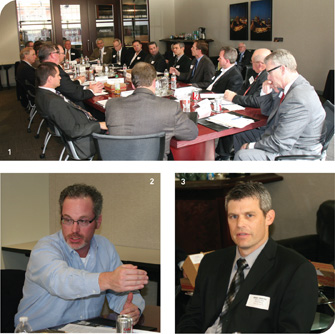
1. Interest in developments within the engineering sector drew a full house at Ingram’s offices in the Crossroads district. | 2. Younger engineers, said Jeff Brizendine, are helping drive technological change throughout the industry. | 3. When it comes to problem-solving, a typically Midwestern sense of ownership courses through the engineering work force, said Mike Owens.
As Joe Marsh, senior vice president with Terracon consultants, noted, there is a good deal of work-sharing that goes on not only within an office, but also among regional offices of a given firm.
“Ten years ago,” explained John Weiskopf, “we acted like individual offices across the nation.” That is not so any more. “Being able to share the work is very important.” If his firm has a big project, say, in California, it is not unusual to take the Kansas City guys and put them on that project or vice versa. “The only issue is you have to manage it,” he cautioned.
Jim Lewis sees economics as a driving force behind inter-office collaboration. Given that service businesses are more or less based on billable hours, it is critical, he believes, to “take advantage of your work and keep all of your offices busy. It affects your profitability.”
Cliff Greenlief agreed that there was an economic component, but he argued that there were ancillary benefits as well. “When you can share that knowledge among all these different offices,” he said, “you’re raising the bar for the entire company.” Sharing, he said, allows engineers an opportunity to work on the kind of projects they may have always wanted to but have never had the opportunity to do.
Technology
Another factor that helps diversify the talent is technology. “The technology is enabling us to utilize what we all know to bring more value,” said Mike Fenske. “Multiple offices and technology combine to allow us to be a bigger organization.”
Mike Odrowski, branch manager with Tetra Tech in Kansas City, related that his firm used five different offices throughout the Midwest to complete a major design on one municipal project. “Through technology,” he said, “whether live Webcasts or server sharing, we were able to work pretty seamlessly.”
The younger talent is driving the technology shifts, argued Jeff Brizendine, project manager at AECOM. “They’re used to working with someone and not seeing them sit across the table,” he said. “All they see is a computer screen, and they’re typing. Yet in the mind, they see the person that they’re talking to.”
Drew Rimmer, a principal at Hen-derson Engineers, offered a somewhat contrary opinion. He explained how his firm had collaborated with Burns & McDonnell on a large international project. “There’s a lot to be said for having people local,” said Rimmer. “We can go to their office anytime, collaborating, working with the other architects, understanding how the buildings are going together, and it’s hard to do that remotely.”
Recruitment
“For the students or potential recruits from all over the Midwest,” said Steve Hofmeister, “Kansas City is very easy to recruit to.” And even those who are hesitant, Hofmeister observed, often change their minds once they get here.
When new recruits come here, said Jim Lewis, they tend to stay. “We don’t lose as many people to attrition as firms I know on the two coasts,” he noted.
“This city is a nice place to raise a family,” affirmed Mike Owens, vice president of engineering at SSC. This is a factor that contributes to the high retention. He noted, too, that many of the engineers in the area have a rural upbringing and have the attitude of “Give me something to do and I’ll take care of it. I’ll figure it out.”
Drew Rimmer said he had polled some of his younger recruits as to why they came to Kansas City and why they chose to stay. What he heard went something like this: “Well, if I didn’t like it at Henderson, I knew I could go to Black & Veatch.” Rimmer believes that the number of firms in town really helps attract younger engineers because of the depth of opportunity.
“There are advantages to having so many licensed engineers and engineering firms in your city,” agreed Hofmeister. If one market sector gets slow, a young engineer can move to another firm with an emphasis on a different sector.